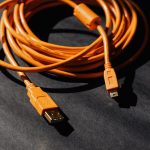Fire safety and cable management in your workstation are vital for preventing hazards. Poorly organized cables can lead to overheating, electrical fires, and equipment failure. To avoid risks, label cables, bundle them with ties, and keep them off the floor. Regularly inspect for wear and clear clutter from around electrical outlets. Conduct fire drills and ensure exits are unobstructed for quick evacuation. Continue exploring effective strategies to enhance safety and organization in your workspace.
Table of Contents
Key Takeaways
- Implement effective cable management to reduce the risk of overheating and electrical fires caused by tangled or unsecured cables.
- Regularly inspect cables for wear and replace any damaged ones to mitigate shock hazards and equipment malfunctions.
- Keep emergency exits and pathways clear by organizing cables with ties, clips, or management boxes to prevent obstructions.
- Designate specific areas for power strips and avoid overloading them to maintain safe electrical systems.
- Conduct fire drills and educate employees on fire hazards related to cable management to enhance workplace safety awareness.
Understanding the Risks of Poor Cable Management
While you mightn't think twice about the cables running through your home or office, poor cable management can pose significant risks.
Cables that are tangled or improperly secured can easily overheat, increasing the likelihood of electrical fires. When these cables rub against each other or sharp edges, they can fray and expose wires, creating dangerous shock hazards.
Additionally, cluttered cords can obstruct emergency exits and pathways, making it difficult to evacuate during a fire. You mightn't realize it, but loose cables can also lead to equipment malfunction, resulting in data loss or costly repairs.
Cluttered cords can block emergency exits and lead to costly equipment malfunctions. Prioritize cable management for safety and efficiency.
Being aware of these risks is crucial to maintaining safety in your workspace and preventing potential disasters. Take action to protect yourself and your environment.
Best Practices for Effective Cable Organization
Addressing the risks of poor cable management can significantly enhance your safety and efficiency. Start by identifying and labeling each cable, making it easier to trace and manage them.
Use cable ties or Velcro straps to bundle cables together, reducing clutter and minimizing tripping hazards. Designate a specific area for power strips, ensuring they're not overloaded.
Keep cables off the floor whenever possible, using wall-mounted clips or cable trays. Regularly inspect your cables for signs of wear, replacing any damaged ones immediately.
Finally, educate your team about the importance of maintaining cable organization; a collective effort can foster a safer and more productive workspace. Implementing these best practices will simplify your environment and help prevent potential fire hazards.
Identifying Fire Hazards in the Workplace
To ensure a safe work environment, it's crucial to identify potential fire hazards that could threaten your team's well-being.
Start by inspecting areas where heat-generating equipment is used, like computers and printers. Overloaded power strips can pose significant risks, so check for excessive plug-ins.
Pay attention to clutter around electrical outlets and appliances, as it can obstruct airflow and lead to overheating. Additionally, look for flammable materials, such as paper or fabric, stored near heat sources.
Regularly examine your workspace for damaged cables or wiring, as these can spark fires.
Lastly, ensure that fire exits and extinguishers are easily accessible and clearly marked.
Implementing Fire Safety Protocols
Implementing fire safety protocols is essential for safeguarding your workplace against potential disasters. Start by conducting regular fire drills to ensure everyone knows evacuation routes and procedures.
Install smoke alarms and fire extinguishers in accessible locations, and make sure they're regularly inspected and maintained. Educate your team on fire risks, emphasizing the importance of reporting hazards immediately.
Ensure smoke alarms and fire extinguishers are accessible and well-maintained, while educating your team on fire risks and hazard reporting.
Designate fire wardens to oversee safety measures and facilitate communication during emergencies. Keep emergency exits clear and unobstructed, and ensure that electrical equipment is used safely to prevent overheating.
Lastly, review and update your fire safety plan periodically, adapting it to any changes in your workspace or workforce. By taking these steps, you'll create a safer environment for everyone.
Tools and Equipment for Cable Management
After ensuring fire safety protocols are in place, it's time to focus on another critical aspect of workplace safety: cable management.
You'll want to gather essential tools and equipment to keep cables organized and secure. Start with cable ties or Velcro straps to bundle cords neatly. Use cable clips or adhesive holders to attach cables to desks or walls, preventing tripping hazards.
A cable management box can conceal excess cables, keeping your workspace tidy. Consider using cable sleeves for added protection and to maintain a uniform appearance.
Finally, invest in a label maker to identify cables easily, reducing confusion and improving efficiency. With the right tools, you can create a safer, more organized workstation that enhances productivity.
Creating a Culture of Safety and Organization
When you prioritize safety and organization in the workplace, everyone benefits from a more efficient and secure environment.
Creating a culture of safety requires commitment from all team members. Here are some key strategies to foster this mindset:
- Encourage open communication about safety concerns.
- Implement regular safety training and drills.
- Simplify cable management to reduce hazards.
- Recognize and reward safe practices among employees.
Frequently Asked Questions
How Often Should I Inspect Cables for Damage?
You should inspect cables regularly, ideally every month. Look for signs of wear, fraying, or damage. If you notice any issues, replace them immediately to ensure everything runs smoothly and safely. Don't wait too long!
What Types of Cables Are Most Prone to Overheating?
Certain cables, like those made from copper, can overheat easily, especially when overloaded or poorly ventilated. You should watch for damaged insulation, frayed wires, or signs of wear that may increase overheating risks.
Can I Use Duct Tape for Cable Management?
You can use duct tape for cable management, but it's not the best choice. It might leave residue and lose its stickiness over time. Consider using cable ties or clips for a more reliable solution.
Are There Specific Fire Safety Regulations for Home Offices?
Yes, there're specific fire safety regulations for home offices. You should ensure smoke detectors are installed, have fire extinguishers accessible, and avoid overloading electrical outlets. Regularly check your equipment to minimize risks. Stay safe!
How Do I Safely Dispose of Old Electrical Cables?
To safely dispose of old electrical cables, you should check local regulations, find a recycling center, or participate in an e-waste collection event. Don't throw them in regular trash; they can harm the environment.




